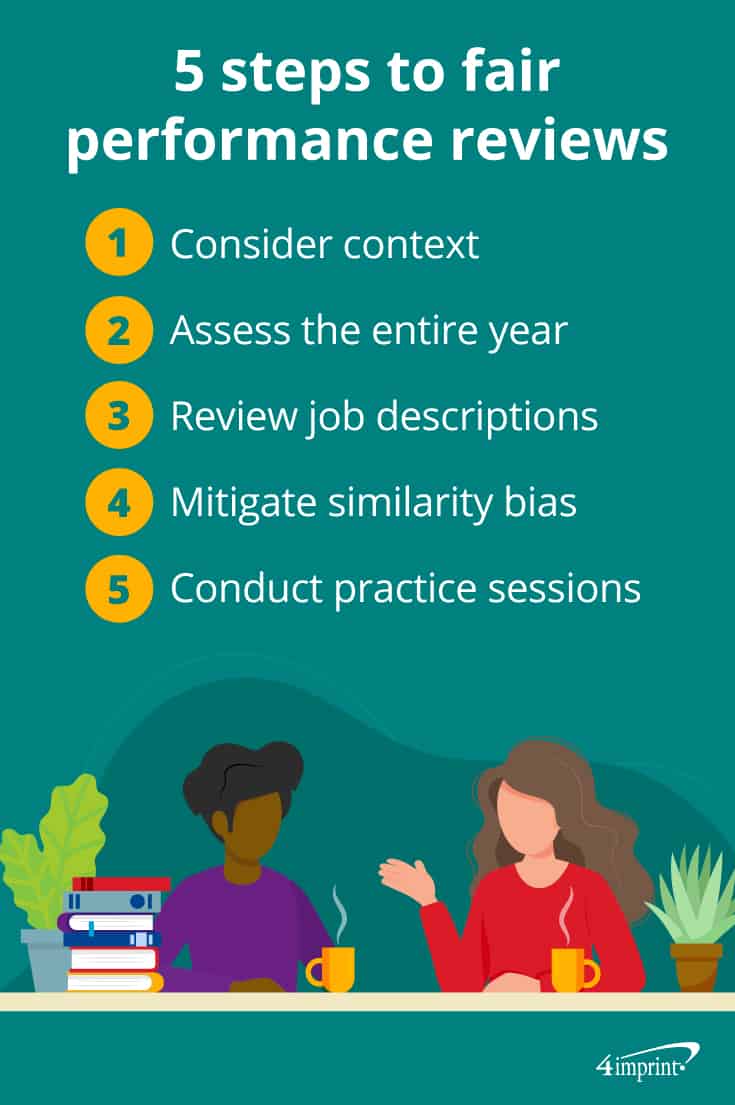Organizations that conduct effective performance reviews are 30% more likely to meet their financial goals and three times as likely to successfully navigate change.

Performance reviews don’t have to be limited to just once a year either. In fact, 92% of employees desire more feedback. The most effective performance reviews are transparent and fair, with the goal of recognizing employees and helping them move on to greater things within the company. Consider that 24% of staff members are considering leaving due to a lack of performance feedback. Knowing how to conduct fair performance reviews is crucial.
5 ways to conduct fair performance reviews
- Keep context in mind
- Review the entire year
- Brush up on job descriptions
- Mitigate similarity bias
- Conduct practice sessions

1. Keep context in mind
Over the last two years, people’s lives have drastically changed, especially if they’re a parent or caregiver. Keep this in mind when considering penalizing a team member for absences. Context matters. For instance, consider excusing absences in cases where their child was unable to attend childcare for a couple of weeks because of covid precautions. By asking questions, you can discover important information like:
- Was the time away necessary given an employee’s specific circumstances?
- Was their absence due to something your organization could help them work through?
- When they were at work, how productive were they?
Put yourself in your employee’s shoes and offer grace when warranted. Employees will appreciate getting fair assessment based on their specific circumstances. This could lead to them being more loyal in the future. After the review is complete, provide employee appreciation giveaways, like a set of slate coasters, a vacuum bottle or a wireless speaker.
2. Review the entire year
It’s easy for leaders to focus on an employee’s current performance. To be fair, though, a performance review should cover the entire year. Remind managers to look at staff’s performance 10 months, six months and three months ago. To help leaders remember that far back, provide them with a journal and pen set to jot down things they notice throughout the year. Give employees one too so they can more easily remember their triumphs and successes from the past year.
3. Brush up on job descriptions
Before performance reviews, ask managers to read employees’ job descriptions. This helps them understand how the work the employee has done aligns with what they were hired to do. It keeps the review fair by preventing leaders from misunderstanding what an employee is supposed to be doing and underscoring them for not performing certain tasks. On the flip side, it can also shine a light on employees who are doing things outside of their job description and may be ready for a promotion.
4. Mitigate similarity bias
Often unconsciously, leaders rate employees who are “like” them—in gender, values or parental status—as better. Help leaders truly focus on performance by asking them to find a few things in common with each employee before their review.
Whether it’s a hobby or working together on a difficult yet successful project, identifying common ground before the review works to lessen similarity bias. Give leaders the opportunity to bond during the review, by handing out mugs filled with piping hot coffee or delicious hot chocolate.
5. Conduct practice sessions
Before any review, gather managers to practice and share insights. Provide fake yet realistic files for them to assess individually and then as a group.
Use files that represent both new hires and long-term employees. Leaders can compile their findings and compare them, discussing if they agree or disagree with another person’s assessment. They can discuss topics like:
- How does this employee contribute? Are their contributions valuable?
- What specific data justifies the assessment?
- Is there a bigger picture that could be missing here?
Boost staff loyalty—and growth
With these five ideas on how to conduct performance reviews so they’re as fair and unbiased as possible, staff loyalty will grow by leaps and bounds. And so will your business.
Key Takeaways:
- Consider context
- Review past and present
- Find common ground
- Practice
